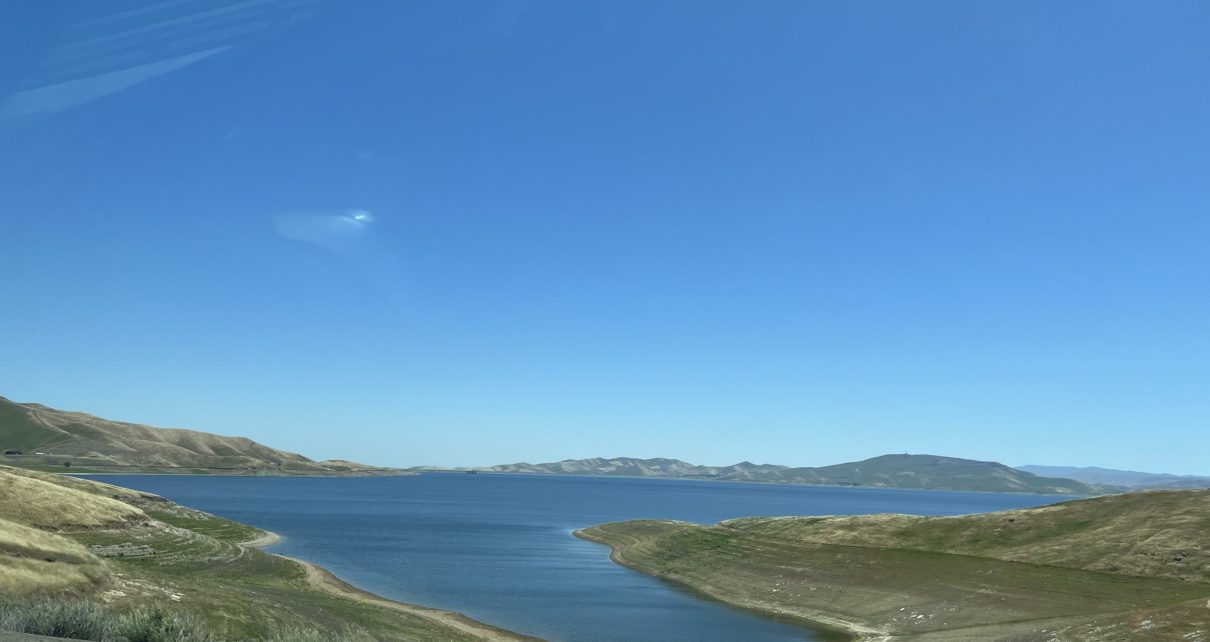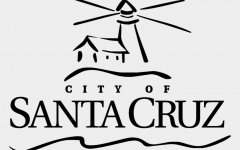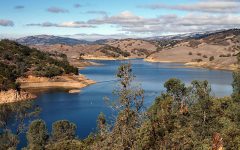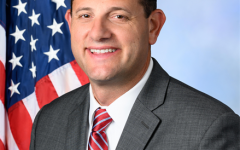
California San Luis Reservoir. (Photo: Katy Grimes for California Globe, April 2024)
Ringside: Congress Comes to Santa Nella to Talk About Water
If water agencies were to adopt up-to-date reservoir and flood management practices, they could easily supply more water to farmers
By Edward Ring, September 19, 2024 6:42 am
 The Great Valley of California, one of “the more notable structural depressions in the world,” covers an area of 20,000 square miles. More than half of it, about 6.7 million acres, or over 10,000 square miles, is irrigated farmland. If you drive south on the main north-south artery, Interstate 5, orchards and cultivated fields appear as soon as you drop out of the foothills around Red Bluff. For the next 430 miles, until you begin ascending the Tehachapi Mountains far to the south, everywhere you look there is agriculture.
The Great Valley of California, one of “the more notable structural depressions in the world,” covers an area of 20,000 square miles. More than half of it, about 6.7 million acres, or over 10,000 square miles, is irrigated farmland. If you drive south on the main north-south artery, Interstate 5, orchards and cultivated fields appear as soon as you drop out of the foothills around Red Bluff. For the next 430 miles, until you begin ascending the Tehachapi Mountains far to the south, everywhere you look there is agriculture.
About 75 percent of California’s total agricultural production occurs in the Central Valley. According to the Public Policy Research Institute, in 2018, the Central Valley had an estimated 3.5 million acres planted with trees and vines, 2.1 million acres had grains, 1.2 million acres had alfalfa, 750,000 acres had vegetables (including tomatoes which are technically referred to as “non-tree fruits”), and not quite 900,000 acres had corn. Since 2018, roughly 750,000 acres have been taken out of production, with another million at risk. The reason? Not enough water.
In response to the conventional wisdom that there isn’t enough water in California for agriculture at its current scale, and in particular, to the current management practices of the federal and state regulators that control allocations of water to California’s farmers, a congressional “field hearing” was held on September 6 in Santa Nella, a town situated along I-5 just east of the massive San Luis Reservoir.
The hearing was called by Congressman John Duarte, whose District 13 sprawls across the midsection of the valley from Modesto south to Coalinga. Joining Duarte were four other members of Congress from California, all of them Republicans representing mostly rural districts: Vince Fong, Doug LaMalfa, Tom McClintock, and David Valadao. Also present was the Chairman of the House Subcommittee on Water, Wildlife and Fisheries, Chairman Cliff Bentz (R–Oregon).
Not present were any federal or state officials, despite being invited. The Bureau of Reclamation, U.S. Fish and Wildlife Service, and the National Oceanic and Atmospheric Administration did not send anyone, nor did any state agency. That’s too bad, because the perspective of the farmers who showed up to testify ought to matter to the bureaucrats who are systematically and needlessly destroying their industry.
In his opening remarks, Duarte immediately challenged the idea that there isn’t enough water to go around in California, stating that “California has the largest precipitation bank in the world in the Pacific Ocean right off the largest watershed in the world in the Sierra Nevada Mountains, along with the most fertile valley in the world.”
Duarte is pointing out something that is obvious and ought to be better reflected in water policy. In wet winters, which would include the last two years, over 10 million acre feet of Sierra runoff flows through the Sacramento-San Joaquin Delta and out to the ocean, a volume that is far in excess of what is needed to maintain a healthy aquatic environment in the delta or its tributaries. If we had the infrastructure to safely withdraw a significant percentage of storm runoff in wet years, California’s farms and cities would never again experience water scarcity. It’s really that simple.
What state and federal regulators might have better appreciated, had they bothered to attend this hearing, is how many water supply solutions are available, that if implemented would preserve California’s agricultural industry at its current scale without undermining efforts to restore the Central Valley’s species and ecosystems.
As it is, just updating the Bureau of Reclamation’s process for determining water allocations would go a long way towards helping California’s farmers. William Bourdeau, a farmer on the west side of the San Joaquin Valley (the southern portion of the Central Valley), said this at the hearing: “The Bureau of Reclamation’s delays and overly conservative approach to water allocations this year have had far-reaching and devastating consequences. Despite historic rainfall and snowpack, the Bureau’s allocation announcements failed to account for this abundance, issuing a minimal allocation that did not reflect the actual conditions. By the time a modest increase was announced, it was too late for growers to adjust their plans for the year.”
Bourdeau went on to explain how farming operations, their suppliers, and the processors who purchase their crops, are all required to plan months in advance their commitments for the coming season. For example, when an initial water allocation announced by the federally administered Central Valley Project, or the state administered State Water Project, is only 5 percent of a full allocation, farmers take tremendous risks if they plant more acreage than that amount of water will irrigate, even though allocations are usually increased throughout the spring.
In an interview on September 16, Congressman Duarte claimed that if the agencies were to adopt up-to-date reservoir and flood management practices, using the latest methods to predict precipitation and runoff, they could easily supply more water to farmers without risk of floods or harming ecosystems. Instead, their conservative approach and inability to quickly assess and adapt results in millions of acre feet of water needlessly flowing to the ocean.
Duarte also identified dredging as a relatively inexpensive way to increase the capacity of California’s reservoirs that collect sediment, as well as California’s primary river channels, which if dredged, could accommodate faster runoff. This means more water could be held in dams without risking flooding. Another obvious fix Duarte mentioned was completing the Folsom South Canal, which would allow runoff from the American River to tie directly into the California Aqueduct without having to go through the delta. Raising the Shasta Dam, another obvious and very cost-effective solution, was also on Duarte’s list.
There’s so much more. As we have frequently noted, the fish friendly delta diversions proposal, if realized, could safely withdraw a significant percentage of excess delta runoff during wet winters at an estimated construction cost of roughly $1.5 billion per 1 million acre feet of annual capacity. Compared to most other proposals for additional water supply infrastructure, that is an astonishing bargain. There are many additional supply side solutions including wastewater recycling and urban storm runoff harvesting, both of which we need to do anyway, along with desalination which has the newly recognized virtue of not requiring extraction of PFAS.
But as Jason Phillips, CEO of the Friant Water Authority, testified on September 6, “Without regulatory reform to stop the uncontrolled, unending taking of California’s water supplies in pursuit of the proven failed approach to recover endangered species, there is no amount of new infrastructure, recycling, efficiency, or any other form of water supply development that can bring us to a place of abundance.”
Phillips is absolutely right. We need more water supply infrastructure. But we also need environmentalists and the regulators they control to acknowledge that decades of mandating ever more “unimpaired flows” has not resulted in more salmon or more smelt. Farmers have completely transformed their industry to use water far more efficiently. California’s Endangered Species Industrial Complex needs to engage in reciprocal innovation, and accept tough choices and difficult compromises that are long past due.
- Ringside: EVs and California’s Future Demand for Electricity - December 4, 2025
- Ringside: Politically Viable Water Supply Projects - November 27, 2025
- Ringside: Shifting Costs Does Not Solve California’s Electricity Shortages - November 20, 2025





Considering the volume of runoff through the valley certainly consideration in this matter is decades old and has considered artificial aquifer recharge programs, though level of implementation is unknown. There are successful reverse pumping programs(Texas) that recharge hydrologic basins and lakes.